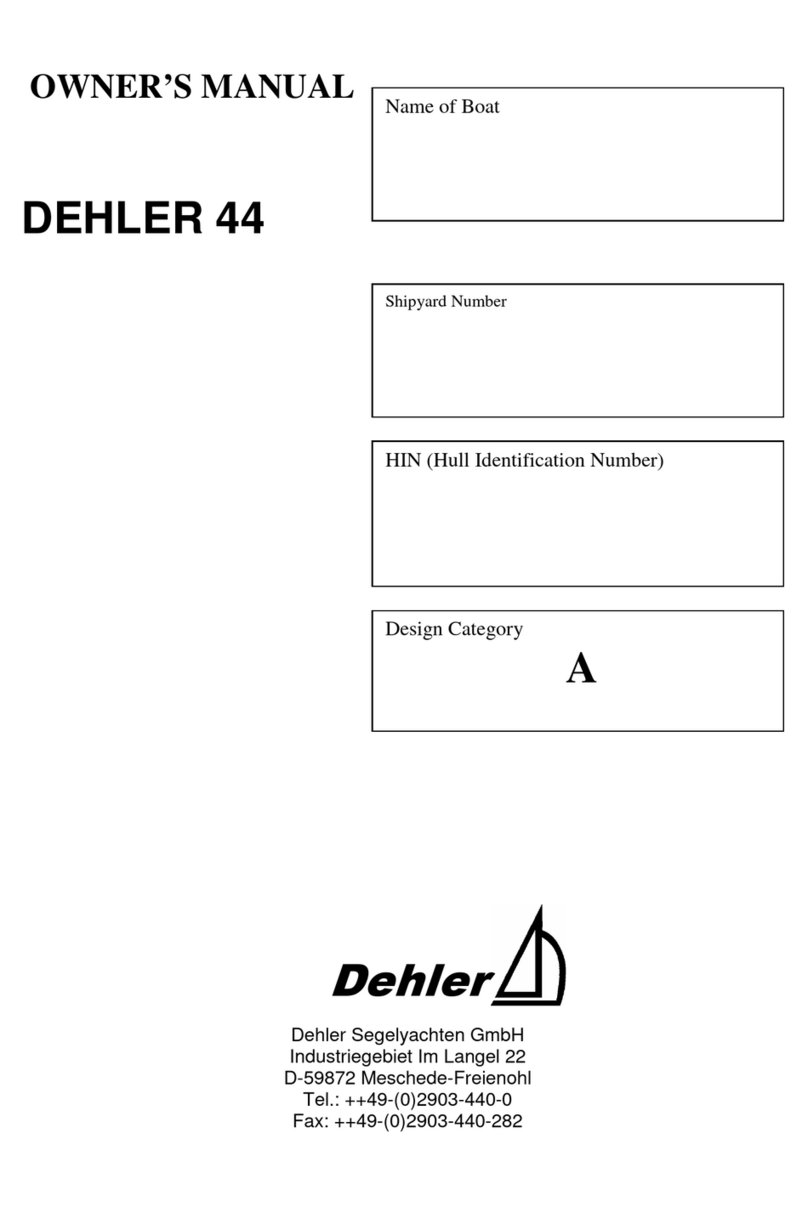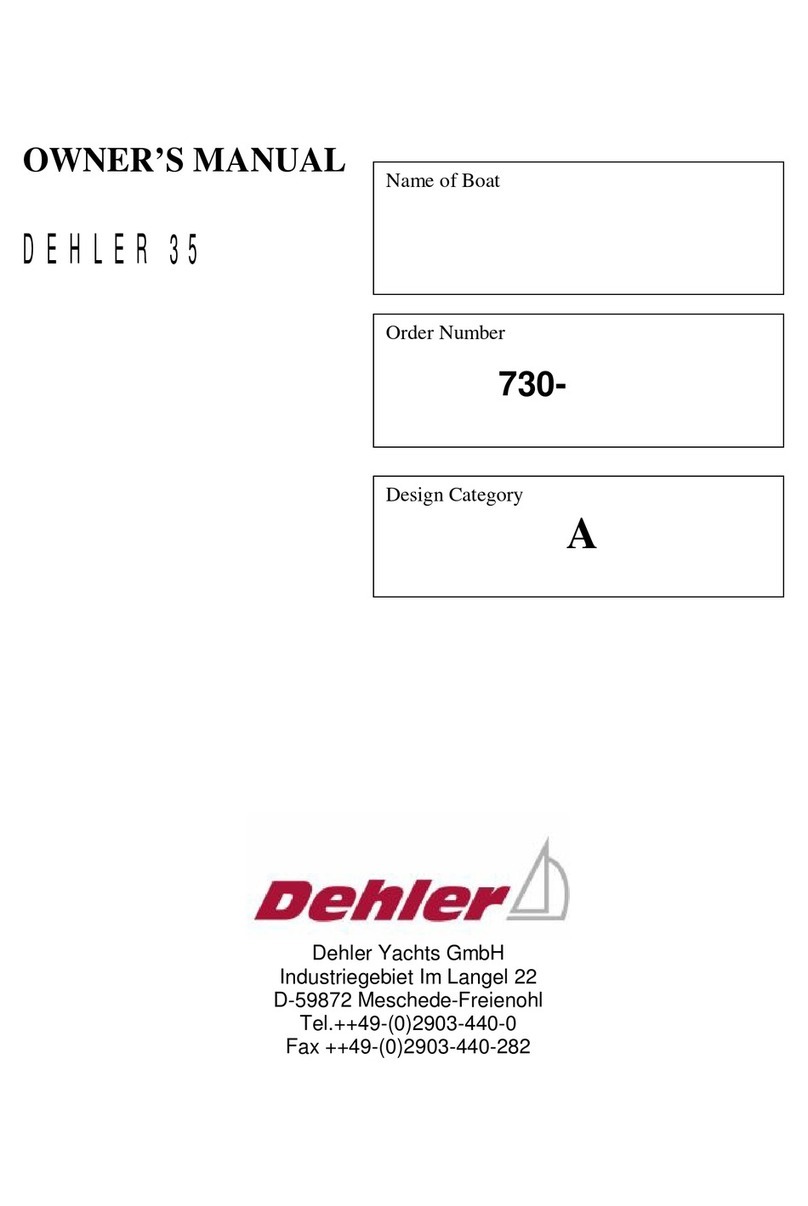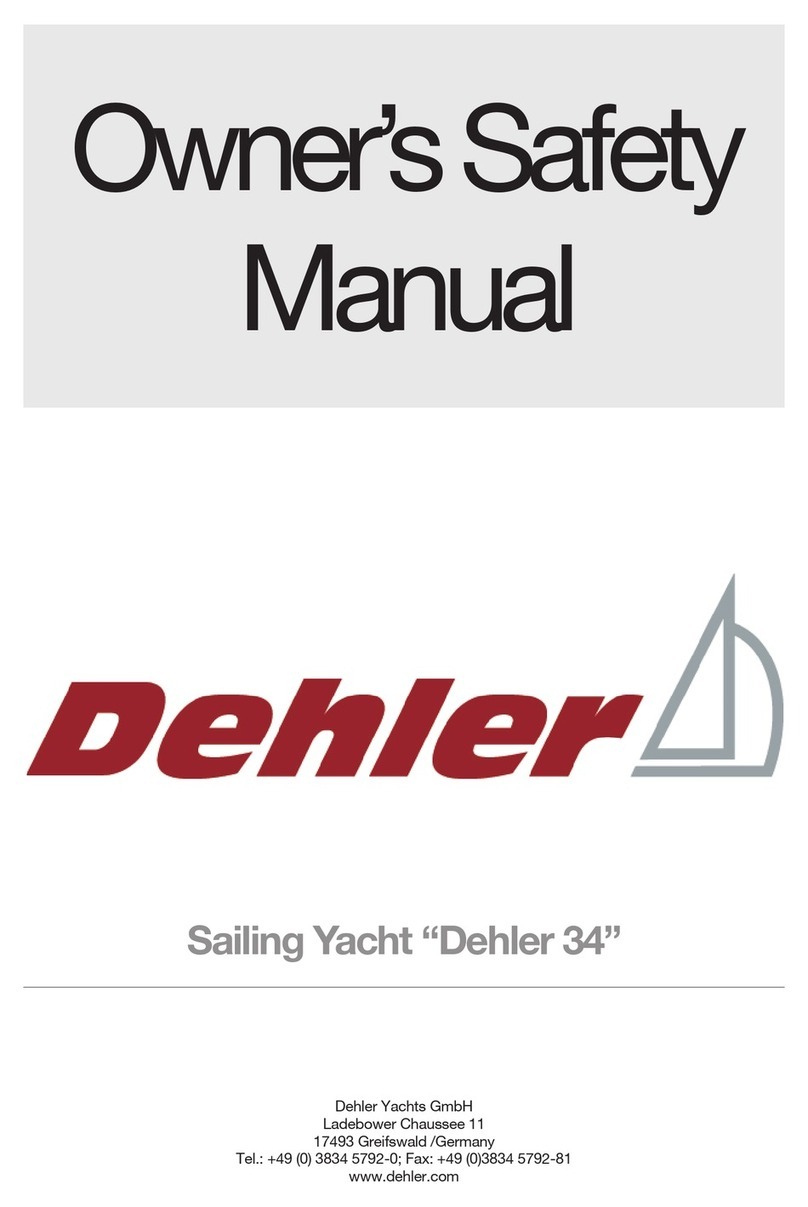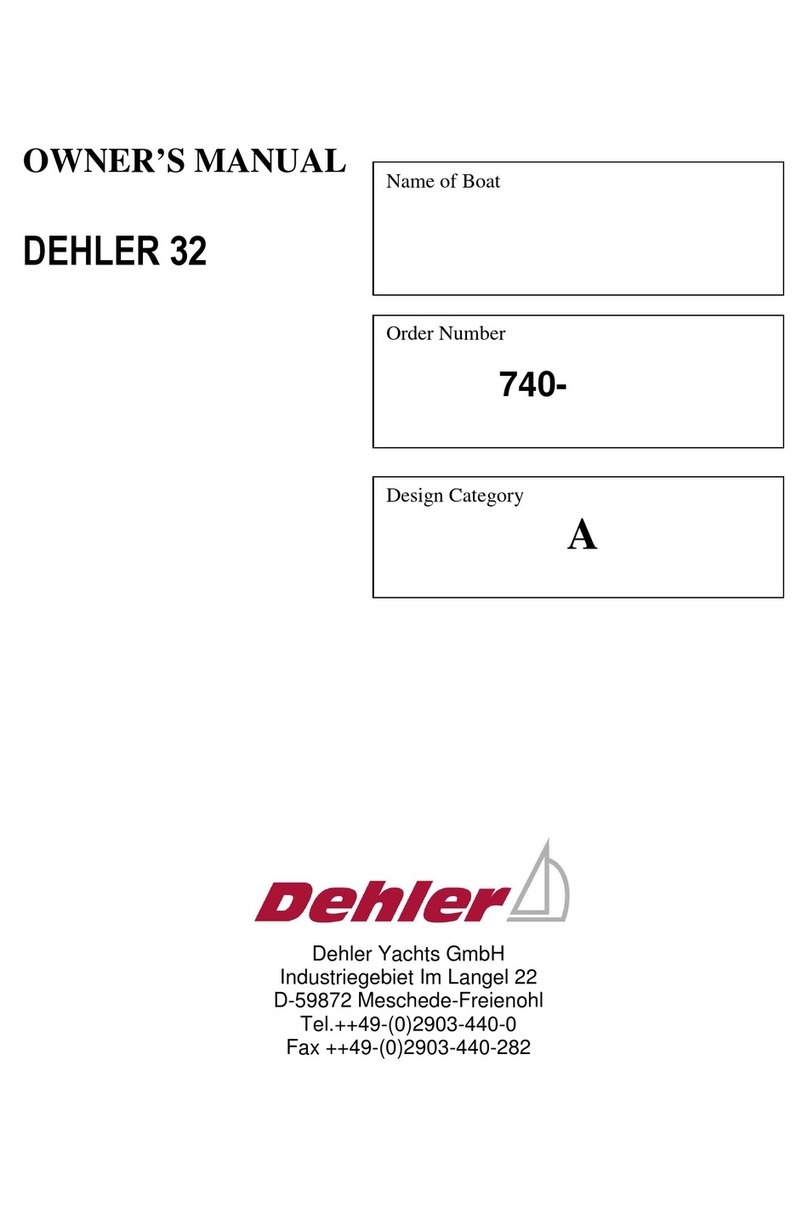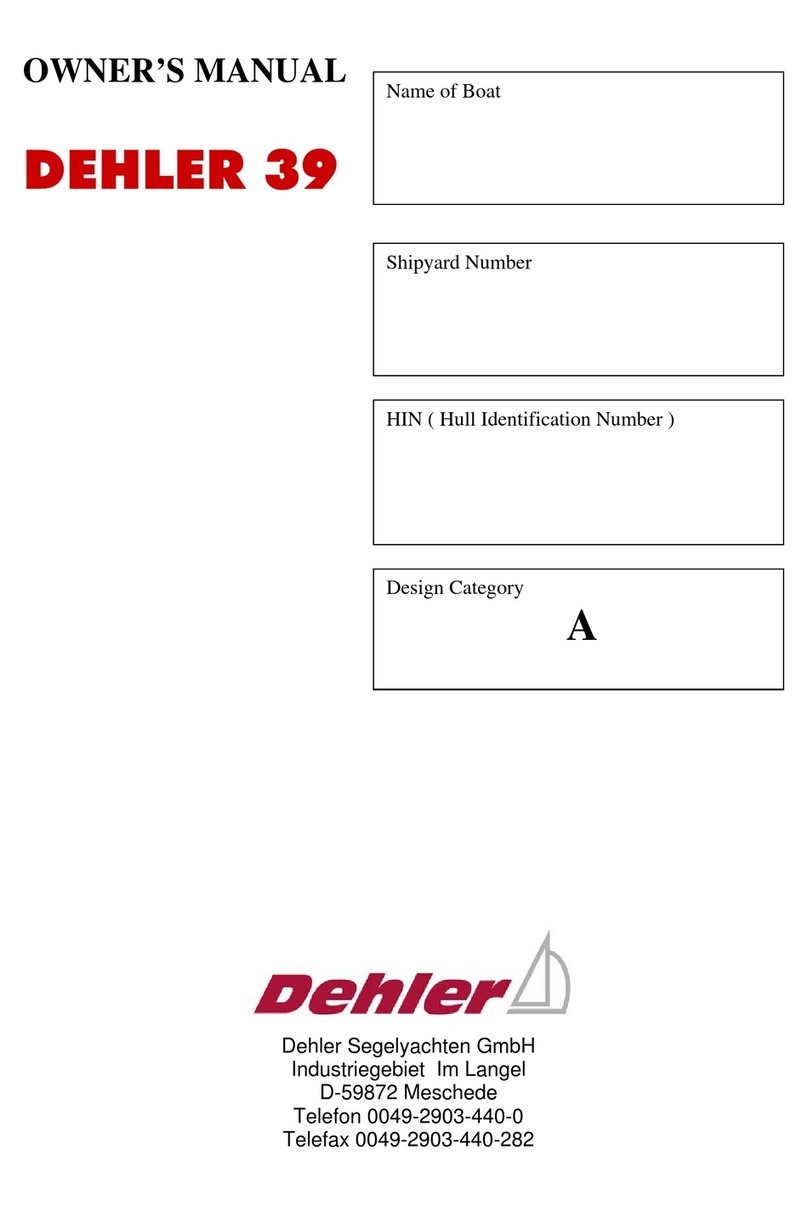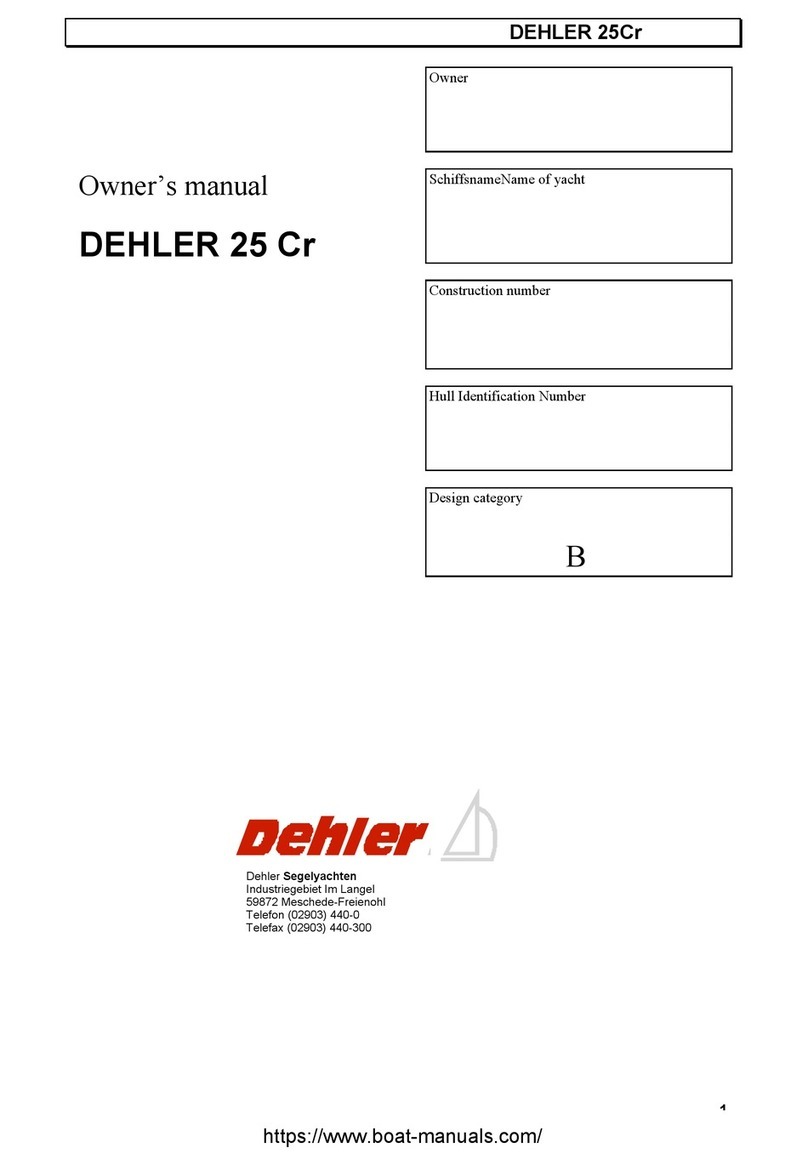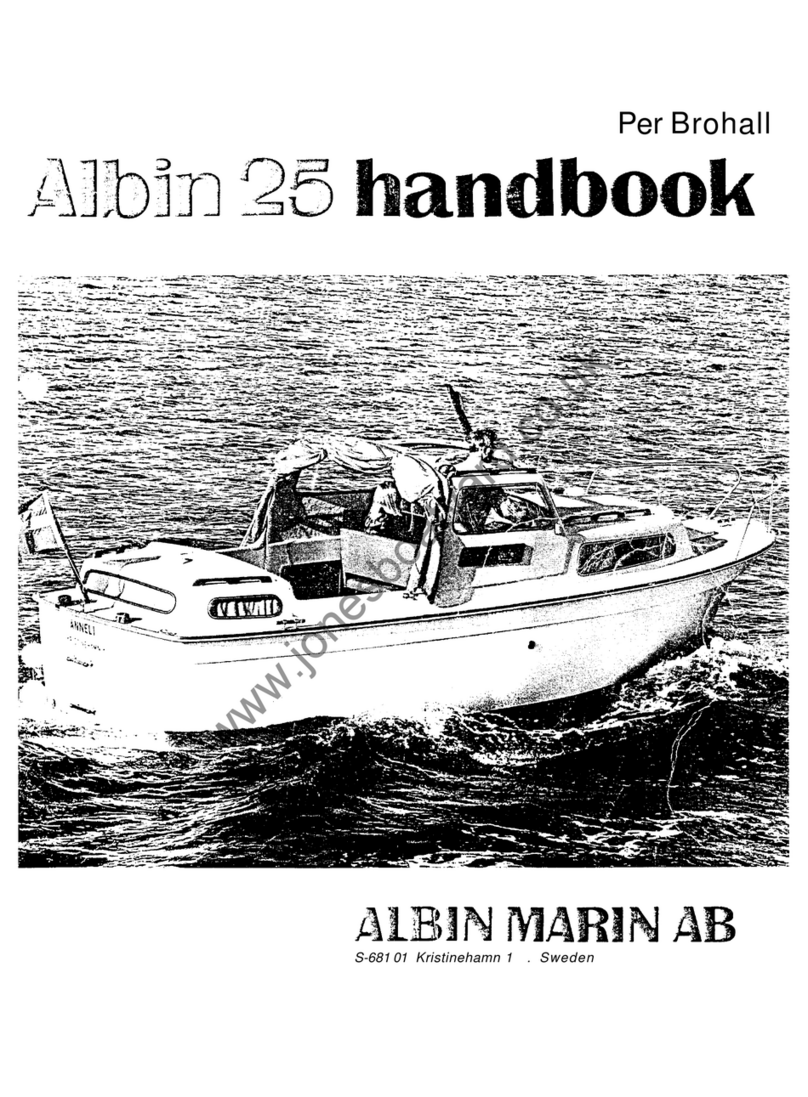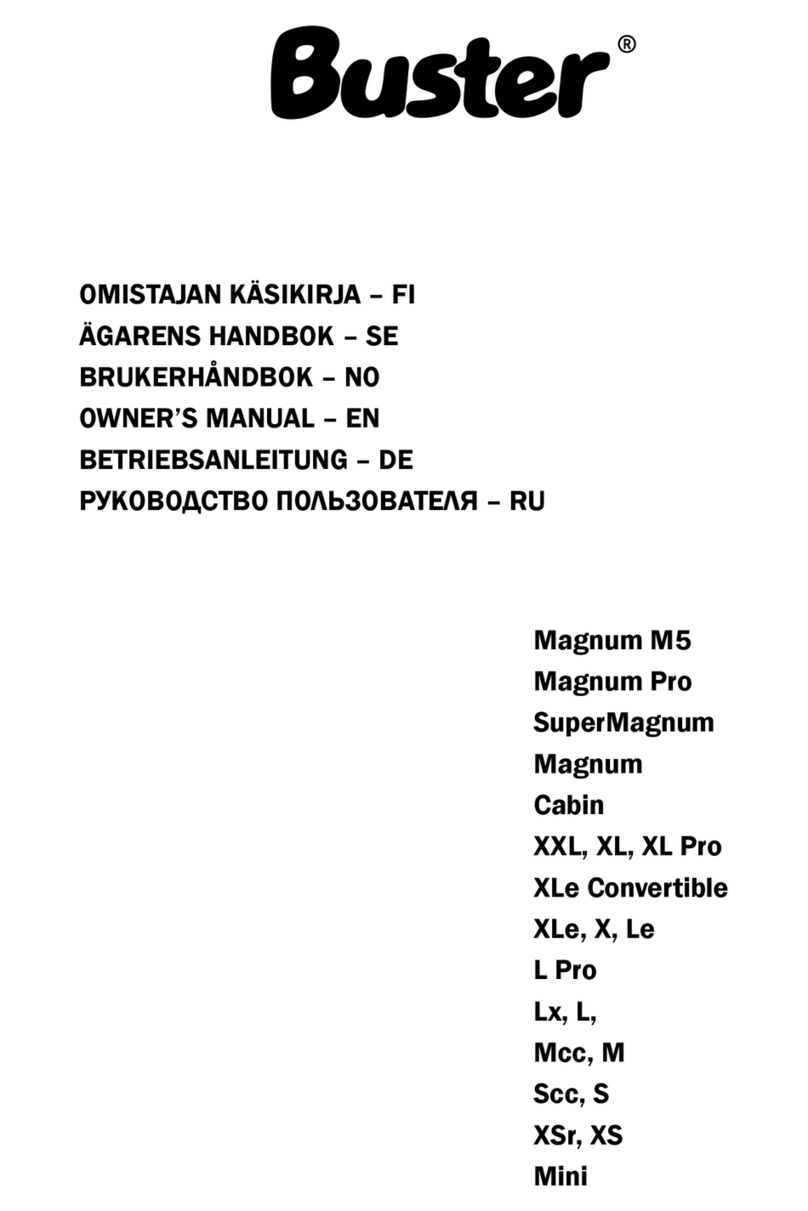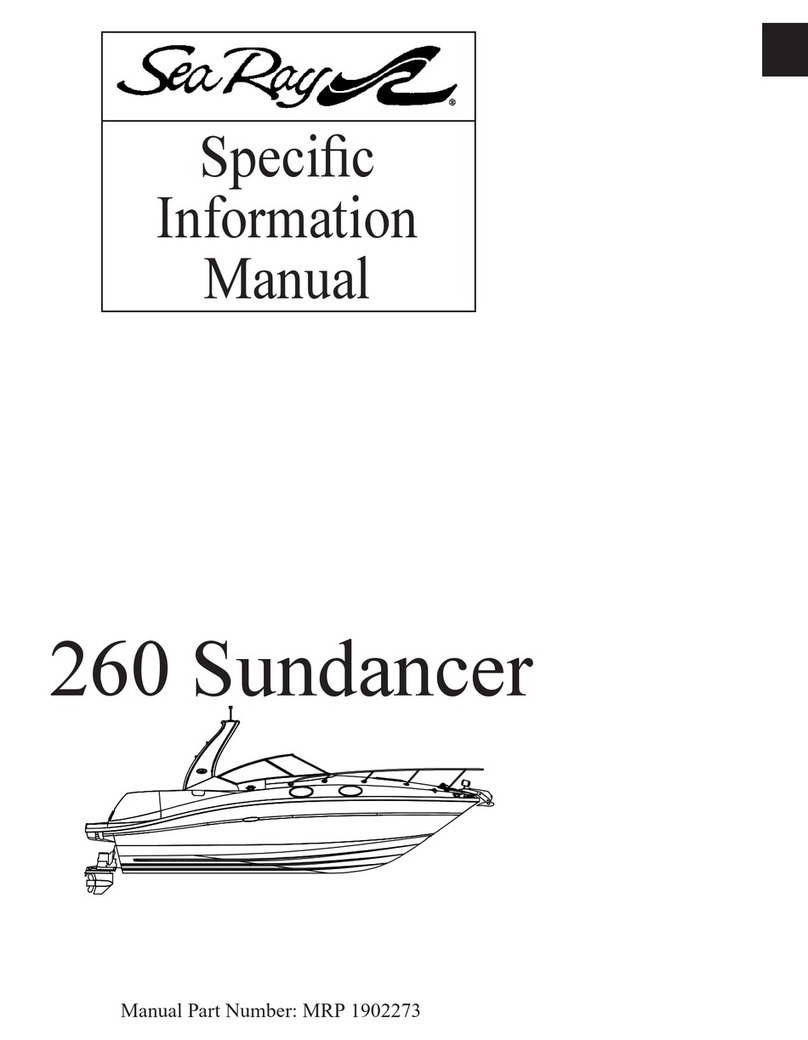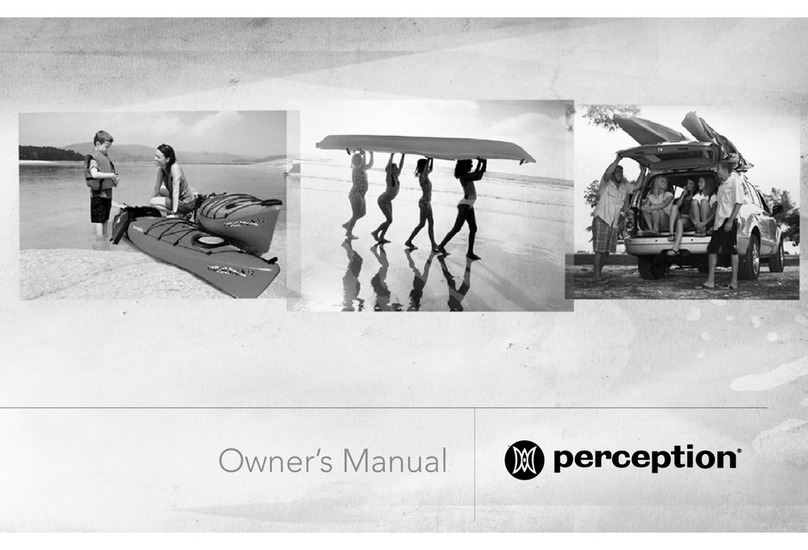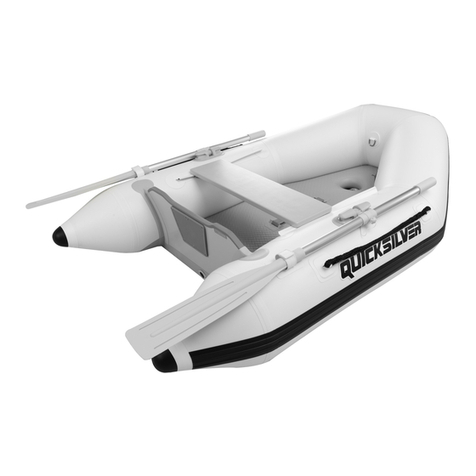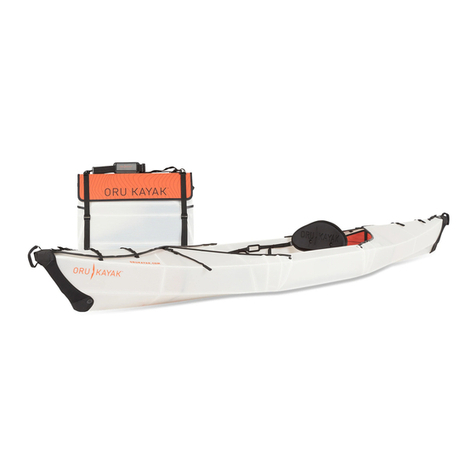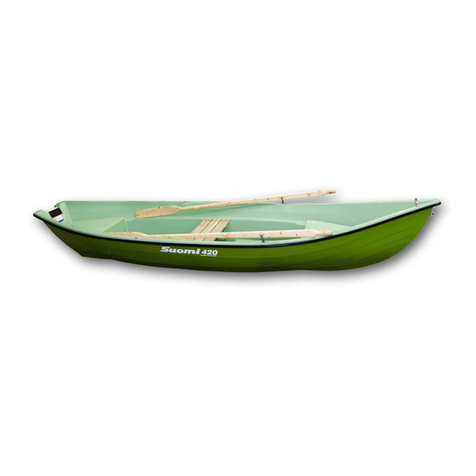Dehler 31 User guide

/
/
I
/
/
/
I
OWNERS
HANDBOOK
DEHLER 31
DEHLER 34
/
/
/
I
I
I
I
/
L
I
-,-
Li
DEHLER.
NEW ROADS TO THE WATER
r
no
Ai-
APPTT.
?P

DEHLER 31
HULL
(Approx):
SAIL AREAS
(App rox):
LO.R. RIG
(Approx):
PRINCIPLE DIMENSIONS
Length 0. A.
30.83 ft.
Length W.L.
24.27 ft.
Beam
10.17 ft.
Draft
4.75 ft.
Shallow draft (optional)
3.60 ft.
Displacement
7.
055
lbs
Ballast
2.866 lbs
Mainsail
282 sq. ft.
No.1 Genoa
296 sq. ft.
Total to windward
578 sq. ft.
No. 3Genoa
198 sq. ft.
Jib
140 sq. ft.
Storm Jib
61 sq.tt.
Trysail
81 sq. ft.
Spinnaker
678 sq. ft.
I
35.lOft.
J
-
1l.15ft.
L.P.
16.73 ft.
P
36.74 ft.
E
13.45 ft.
SL
34. 97 ft.
SMW
20. 07 ft.
9.40 m
7.40 m
3.10 m
1.45 m
1.10 m
3.2 to.ines
1.3 tonnes
26.2 sq.m
27.5 sq. m.
53.7 sq. m.
18.4 sq. m.
13.0 sq. m.
5.7 sq. in.
7.5 sq.m
63. 0 sq. m.
10.70 m
3.40 m.
5.10
M.
11.20 m.
4.10 m.
10.66 m.
6.12
In.

HULL
(Approx):
DEHLER 34
PRINCIPAL DIMENSIONS
Length 0. A.
33.13 ft
Length W. L.
27.23 ft
Beam
11. 15 ft
Draft
5.74 ft
Shallow draft (optional)
4. 75 ft
Displacement
8. 818 lbs
Ballast
3.968 lbs
Mainsail
292 sq -ft.
No 1 Genoa
365 sq. ft.
10. 10 m
8.30 rn
3.40 m
1.75 m
1.45 m
4 tonnes
1. 80 tonnes
27.1 sq. m.
33. 9 sq. m.
SAIL AREAS
(Approx):
Total to windward
657 sq. ft.
61. 0 sq. m.
No.2 Genoa
290 sq. ft.
26. 91 sq. m.
No. 3 Genoa
226 sq. ft.
21. 00 sq. rn.
Self Tacking Jib
201 sq. ft.
18.72 sq. m.
Heavy Weather Jib
167 sq. ft.
15. 5 sq. m.
Storm Jib
67
sq.
ft.
6.2 sq. m.
Spinnaker
780 sq. ft.
72.5
sq. m.
I.C.R. RIG
I
38.71 ft
11.80 m
(Approx):
J No penalty)
11. 97 ft
3.65 m
L.P.
17.96 ft
5.475 m
P
38.71 ft
11. 80 m
E
13.45 ft
4.10 m
SL
38.64 It
11.78 m
SMW
21.55 It
6.57 m

Alan BourdonYachts Ltd
42 Constitution Hill Road. Poole, Dorset BH 14 OQD
Tel Parkstone (0202) 741911
AT Reg 323645I Th
Our Ref: AJB/CEV
DEHLER 34/DEFILER 31
SAILING RECOMMENDATIONS
GENERAL OBSERVATIONS
The Dehler 34 and Dehler 31 class yachts can both be regarded as good performance
family cruiser racers. In other words they not only serve as excellent family cruising
yachts, they can be raced with success. The Dehler 34 hull form has been taken from
the same mould as our previous race winning Dehler dbl 1.0. R. Championship winning
yacht. The slightly modified current Dehler db2
S'-1,744
Z7Z is still
about 80%dbl
hull form. You will see therefore in the case of the Dehler 34 we have produced a
potentially very fast racer cruiser which will perform well under I.0.R., the new
Channel Handicap Rating System for cruiser racers, also in Club Handicap competition.
RUNNING
Due to their moderate to light displacement these yachts are capable of surfing indeed
sometimes planing downwind, which coupled to their J rig, fair sweet sections, excellent
stability and powerful semi-balanced spade rudders, will give an excellent control. Both
yachts are capable when running of carrying spinnakers in winds In excess of 40 knots
true. Under these conditions the yachts can plane in excess of 15 knots which in turn
reduces the apparent windspeed to about 25 knots. There is never any tendency for the
yachts to bury their bows or roll in heavy weather down-wind conditions, providing you
tack down-wind. Compared to a masthead rig it is even more important with a J rig
to always tack down-wind with the apparent wind on the weather quarter. When sailing
down-wind slacken off the adjustable standing backstay, ease the kicking strap slightly
to straighten the mast. This will assist in balancing the
-
helm in both reaching and
running conditions. Also ease the mainsail luff and foot tension, also the genoa luff
tension, to maximise full flowing sails.
REACHING
The Dehler 34 and Dehler 31 class yachts due to their good stability coupled to a rig
configuration can carry a full size spinnaker when reaching in quite strong winds. In
the light of experience we have found that a narrow headed heavy weather spinnaker is not
really worth the investment. When the wind becomes too strong to sensibly carry a
spinnaker on any reasonable point of sailing allowing the boat to heel too far and broach,
you will sail much faster maintaining a straight line course by flying a genoa or heavy
weather headsail. You can soon check this point by checking and assessing your speed
through the water. Naturally the broader the reach the longer you can carry a spinnaker
In a given wind strength. It follows you can, at times, when in doubt carry a spinnaker
j) sail low then reach up under genoa to the next mark. Ihis tactic can often pay, particu
Dehler Ydch
Directors:
continued/
Alan Bourdon
Julia Bourdon
Vdn I)
F)

2
larly when sailing on a long off-shore race. The chances are in long races the wind
direction invariably changes giving you the advantage of carrying a spinnaker all the
way. This is a judgement you can only make on the day of the race
)
coupled to an
assessment of the weather pattern, charts, tidal flow and E.T.A. to the next mark
on the course. Please forgive me for perhaps stating commonly known much accepted
facts and getting myself involved with racing tactics, a complex subject, well explained
by many people who are far more competent than I. The point I am attempting to
stress is the importance of complete concentration particularly under reaching con-
ditions when the crew can at times sit back and switch off. There can be no doubt
about it, when reaching (and indeed running) under really heavy weather conditions
the genoah3s very definite advantages over a spinnaker allowing you, for example
)
to steer a much steadier and straighter course to the next mark. It is deceptive, you
always appear to be travelling faster when a yacht is well heeled and making a lot of
fuss through the water. This Is not so, check your speed.
TO WINDWARD
The Van de Stadt Designed Dehier 31 and Dehier 34 class yachts enjoy a good performance
to windward, due to their excellent stability. This is where the rig configuration
with adjustable backstay pays, in that you can control the mainsail shape so effectively,
flat in strong winds and full flowing in light winds opening the leech with a good twist
away, particularly in the top third of the sail. Adjusting the kicking strap to windward
with particular reference to the way the mainsail leech can be set is most important
to get the best from any fractionally rigged yacht. Mainsail luff, foot, cunningham and
flattening reef tension is of importance to achieving the best sail shape to windward.
In wind strangths up to 25 knots (apparent) you can still just about carry an unreefed main-
sail well flattened and feathered with a well twisted open leech and the main boom set
well down the track. in this wind strength we would recommend hoisting a 110% almost
full hoist No. 3 genoa, in other words reduce the genoa overlap quickly as wind speed
increases as opposed to previous thinking, i.e. reefing the mainsail and carrying a
larger overlap genoa. Excessive genoa overlap demands the sheeting of the mainsail
well inboird due to the backwinding effect between the two sails, a situation that has
been maintained for many years, particularly with masthead rig yachts where the genoa
becomes the main driving force. In other words with J rig yachts the mainsail must be
made to work more efficiently to windward by reducing the overlap quickly and allowing
the sail to twist away, especially above the main hounds. To windward with particular
reference to J rig and the reintroduction of large mainsails, a good mainsheet man can
be regarded as just about the most Important crew member on deck, especially when
beating to windward.
BASIC POINTS TO REMEMBER
(a) Never overpress the yacht so that the vessel heels over 25 degrees continuously.
In gusting conditions, however, heeling in excess of 25 degrees for short periods is
acceptable as you must carry sufficient sail to perform efficiently in the average wind
strength prevailing. This is where the mainsheet man in careful adjustment and easing
the main boom down the mainsheet track can be regarded as just about the most important
crew member on deck.
continued
/
-~r

3
(b)
Sail flutter particularly in the leech of the main sail does not appear to slow
the boat down when sailing in hard winds or gusting conditions.
(c)
You will win more races by "flowing and going" rather than "pinching and
flinching". The only time it pays to pinch a little is when the yacht can just leebow
an adverse tide.
(d)
More races will be won by easing sheets. There is a tendancy generally among
the crew as tension mounts in close racing conditions, to over pin the mainsail and
certainly the headsail.
(e)
Keep the yacht in first class condition at all times. Delegate crew members
to being reponsihie fotmaintaining certain items of equipment. For example,
greasing winches, frequently checking for chafe in the rig and sails with particular
reference to mast sheaves, blocks, etc.
(f)
Keep the yacht light by checking and if necessary by removing all gear and
equipment not required by the racing rules on the day of the race - remember
these yachts are capable of planing.
(g)
Bottom finish is all important. For the cost of applying anti fouling and the
heavy labour costs of thereon smoothing and burnishing the anti fouling, perhaps
twice a year, you can in preference sail on a polished gelcoat finish and scrub
afloat say every 10-14 days. Alternatively "dry sail" the yacht just like the dinghy.
SAIL COMBINATIONS TO WINDWARD
1.
Full mainsail with varying degrees of mast bend, luff and foot tensions, also
cunningham and flattening reef tension with a No.1 light Mylar genoa up to 16 gusting
18 knots apparent. Note:- in the light of new experience we do not see the point in
investing in a number 1 heavy genoa as light Mylar sails appear to cope very well
throughout this wind range.
2.
Full mainsail well flattened and a No.2 Mylar (perhaps Keviar reinforced)
genoa from 16-22 knots apparent wind speed.
3.
Full mainsail sheeted down the mainsheet track, very well flattened with an
open twisting leech and a 110% No.3 Mylar/Kevlar genoa from 20-25 knots apparent
wind speed.
4.
1 or 2 reefs in a well flattened mainsail sheeted down the mainsheet track, and
a No.3 Mylar/Keviar genoa from 23-30 knots apparent wind speed.
5.
2 or 3 reefs in a well flattened mainsail set well down the mainsheet track,
and a No.4 Mylar/Kevlar genoa (heavy weather jib) from 28-40 knots apparent
wind speed.
AGAIN WE REPEAT - NEVER OVERPRESS THE YACHT ON ANY POINT OF SAILING
continued/

0
RIG CONTROL
-
PORT
RiG CONTROL
-
STARBOARD
1.
Spinnaker topping lift
5.
Main Boom Kicker
2.
Genoa Halyard
6.
Mainsail Halyard
3.
Reef 2
7.
Spinnaker Halyard
4.
Reef 1
8.
Spinnaker Downhaul
SELF TACKING .118 SYSTEM

DEHLER - QUICK REEF SYSTEM
BACKSTAY ADJUSTMENT
DEHLER 34
DEHLER 31

—
T
I N
a
Wd
~
N,,Zj
cl
S

REEFING HEADSAIL
/

8
With reference to the DEHLER 31 class yacht. Bearing in mind her more moderate design
compared to the I. OR. influenced DEHTFR 34 hull form, also her very good sail area to
wetted area and displacement, it may well be, with particular reference to windward sailing,
that you nuy have to reduce the sail area more quickly compared to the DEHLER 34. As the
latest yacht within our range further experience is required before we can give precise
recommendations On sailing the yacht at her best. However, it is fair to say as a fast
family cruising yacht designed to the same formula as the DUETTA 86 G.S., also the
larger DEHLER 372, that the DEHLER 31 will perform extremely well on all points of
sailing in varying wind strengths.
THE FOREGOING INFORMATION AND WHEN TO REDUCE SAIL IN A GIVEN WIND STRENGTH
ARE BASED ON THE dbl/db2 ALSO DEHLER 34 UNDER HARD RACING CONDITIONS. WHEN
CRUISING YOU WILL WISH TO REDUCE SAIL EARLIER AS WIND SPEED INCREASES.
THE BEST HELMSMAN AND CREW WILL BE ABLE TO MAINTAIN MAXIMUM BOAT SPEED
WITH THAT LITTLE EXTRA SAIL AREA AS INDICATED. CONVERSELY THE MORE
EXPERIENCED HELMSMAN AND CREW WILL KNOW JUST WHEN TO REDUCE THE SAIL
AREA AND STILL WIN RACES.
The foregoing recommendations are given as a general guide and are based on our collective
experience sailing dbl and db2 class, also DEHLER 34 class yachts, in at times, top World
Championship race winning conditions. There will always be slight differences between yachts
and the current thinking of keen racing yachtsmen and sailmakers. I am sure these sailing
recommendations, however, will help and assist in getting the best out of your fine new
DEHLER YACHT.

Continued/
April 1986
PAGE 9
DEHLER 31/34
FAMILY CRUISERS AND CRUISER RACERS
RECOMMENDATIONS FOR CARE AND MAINTENANCE
FORWARD
We trust the following advice will assist you in maintaining your fine new DEHLER yacht
in first class condition. Much of what we say is common knowledge but we feel there is
no harm in putting it down in print.
MOULDINGS
Mouldings generally can be maintained in good condition by washing down regularly with
fresh water and in the case of stains these can be removed with mild detergents or T-Cut
polishing compounds. We believe that at least once every season the smooth area of
mouldings should be lightly polished with first a T-Cut compound and then polished with
one of the many proprietory glassfibre polishes on the market today. This will help to
maintain the rich lustre within the pigmented gelcoats and reduce bloom. Deeper scratches
and abrasions can generally be rubbed down by wet and dry sandpapers and worked up to a
high finish by the use of cutting compounds, T-Cut and finally polishing. Very deep abrasions
that cut through the gelcoat surfaces which are nominally about 20 tho' thick can be cleaned
out and filled with pigmented polyester resins prior to rubbing down and re-burnishing.
Should the yacht be severely damaged we suggest repairs should be put in the hands of an
experienced Company conversant with handling G.R. P. repairs. The yacht can also be
repaired by Dehler where it might, for example, be necessary to mould new sections of
hull and deck and, thereon graft them into the existing G.R.P. fabrication. We can supply
colour pastes and pigments to ensure the best possible colour match. It must be emphasised,
however, due to colour fade over a period of years we cannot guarantee giving you an exact
colour match. Due to the physical characteristics of G.R. P. mouldings severe damage, for
example, a hole in the hull is usually restricted to a local area and will not affect the general
structural integrity of the yacht. It is also fair to say that even if the hull is ruptured the
characteristics of G.R. P. normally mean the laminate will spring back to its original shape
confining what could be a serious leak into a very small leak of water into the hull. For
example, the writer was aboard a seriously damaged Van de Stadt designed G. R. P. yacht
some years'ago where the hull was badly holed below the water line. With careful pressure
from a seaboot the laminate sprang back into place and was then supported by the anchor
chain in a sail bag in the bilges until the yacht could be hauled ashore some hours later.
Very little water entered the yacht at this time and was eaiIy coped with by the powerful
bilge pump provided.
KEEL
Both deep and shallow draft options are constructed in cast iron and when leaving the factory
are surface coated with three coats of epoxy resin, painted and anti fouled. The keels are
fastened into the hull with stainless steel studs, nuts and plate washers. It is unusual tint
keel bolts should need to be hardened up on this form of construction as opposed to a lead
keel. The keel is initially bonded to the hull with a silicone mastic. If over a period of years
the keel shows signs of rusting particularly over the lower surfaces due perhaps to the yacht
being grounded, the areas affected can be cleaned and wire brushed and painted with a pro-
prietory brand of rust proofing paint prior to re anti fouling.

DEHLER 31/34
SPARS
Spars are painted or anodised with generally alloy or polished stainless steel fittings. It is
inevitable that spars will get scratched and rubbed over a period of time. There is no way
in which an annodised spar can be painted due to the fact that there is no adhesion to this
form of surface treatment. In other words, annodised spars will either have to be stripped
and re-anodised or stripped and painted.
STANDING RIGGING
The standing rigging on any yacht and the
connections into the mast, turnbuckles and
deck connections wanito be checked at regular
intervals, particularly when the yacht is new.
The rigging and fittings
will
give slightly when
the yacht is new and small adjustments will be
necessary to maintain a straight mast. Always
keep the rigging firm. However, a little slack-
ness in the leeward rigging is acceptable as
wind strength increases. In otber words,
never sail with slack rigging for this could
cause uneven tension in the rigging and dis-
tortion in the mast which must always be
regarded as a compression strut which, at
times, Is under some considerable load,
especially when the yacht is driven hard, well
heeled to windward. You will appreciate a
compression strut (in this case a mast) is
designed to be kept straight as possible. The
mast is designed to bend (and must be bent)
a little in the fore and aft plane, especially
when the mainsail is reefed. This is due to
the fact that as the headboard to the mainsail
is drawn down the mast there is some con-
siderable aft loading in the spar which can tend
to invert the mast in the middle and hook the
masthead forward, this is not acceptable.
On three-quarter and seven-eigth rigged yachts
(such as a Dehler 31 and 34) as wind speeds
increase, tightening the backstay will effectively
flatten the mainsail and open the leech. The mast
will bow forward in the middle as the head of the
mast is pulled aft.
RUNNING RIGGING
The great problem associated with running rigging is chafe, ensure at all times that sheets
lead fair from the sails through turning blocks to the winches. Halyards which get twisted
round, for example, the forestay will quickly weaken and fracture. This will also cause
undue wear to the sides of the sheave and sheave boxes. Check your running rigging at
regular intervals also splices, whippings, snap shackles etc. When the yacht is at rest
ensure that all running rigging is spanned away from the mast as continual halyard tapping
against the mast can be irritating and will quickly wear the annodised or painted surface
coatings.
PAGE 10
Continued/

DEHLER 3
1
/
3
4
DECK FITTINGS AND WINCHES
Turning blocks can very often create undesirable side loads and stress into deck fittings.
Ensure that blocks always lay fair to the deck fitting and in line with loads imposed by
sheets and halyards which can, at times, be under some considerable strain.
The modern winch is a highly engineered product and most reliable in operation providing
you keep it well lubricated at very regular intervals. It is surprising how quickly salt
granules from spray wash away this lubrication. Many owners think they require bigger
winches, a situation which is generally solved by servicing their existing winches.
Check lifelines and their terminals (never tolerate slack lifelines) stanchions, pushpit
and pulpit connections at very regular intervals as they can be subjected to pretty heavy
loads at times.
RUDDER
The rudder is designed to be a semi-balanced spade configuration and is usually made from
a very hard loam plastic casting encapsulating the aluminium rudder stock. The rudder
stock has a series of web frames welded to the general structure to adequately support the
rudder blade. Rudder blades are sometimes encased within a light glass re-inforced plastics
moulding. Rudder bearings are generally constructed in water lubricated nylon. Anti-fouling
should be applied as the general underwater surfaces of the yacht.
WHEEL STEERING
WHEEL STE FlUNG SYSTEM
When wheel steering is fitted, it is operated on the
Dehler 31/34,by chain and wires through blocks to
a quadrant. Inspect, adjust and lubricate steering
mechanism at regular intervals.
All yachts fitted with a wheel steering system
should be equipped with an emergency tiller
which fastens to the top of the rudder stock
where it protrudes from the cockpit moulding.
Continued/
April 1986
4—
PAGE 11

DEHLER 31/34
TILLER STEERING
When a tiller is fitted it is connected directly to the top of the rudder stock and there is
usually a friction lock device incorporated which allows you to leave the helm from time
to time when sailing short handed. On leaving the vessel, especially in tidal conditions,
always securely lash the tiller so that the rudder is fore and aft in the vessel. Never
steer the yacht with the tiller raised above the designed limit as this will distort and
strain the connection to the rudder stock.
COMPASS
The modern compass is very efficient in its operation but it is advised that when the
yacht is new a Compass Adjuster is employed to check the yacht through 360 and also
check for heeling error. Ensure that no metal objects are put close to the compass as
it can cause deviation. The addition of a handbearing compass is always worthwhile
equipment, for example, the Brookes and Gatehouse Herron D. F. equipment. If in
doubt, the main compass can be checked from time to time against a good handbearing
compass.
SAILS
Manmade fibre sails can be hard worked but remember to wash them down regularly
with fresh water and stow in a dry condition. If you have to stow when wet spread the
sails away from cushioned upholstery or make a loose stow in the sail bag provided.
Check the sails regularly for chafe on the stitching, especially around the batten pockets £
where the sail can rub against lifelines and standing rigging. Never leave the mainsail
bent on the boom for long periods without using a sail cover, sunlight affects the strength
of synthetic sail cloth, particularly nylon. All headsails not in use or being dried out
should be kept stowed in their sail bags. Always fold sails carefully before stowing in
their sail bags for this will improve general stowage below decks significantly.
ENGINE
The modern liesel engine has proved to be very reliable. An instruction manual Is
included with the ship's papers and maintenance recommendations should be observed
at all times. Regular checks should be made on the engine and gearbox oil levels
(particularly when new)and we believe it is fair to say that it will extend engine life
to change the engine oils and filters very regularly as recommended. You will note
an engine hour meter is fitted as standard and this is of great benefit when servicing
your engine to the maker's recommendations.
Check the alternator drive belt tension at regular intervals, particularly when new, due
to initial stretch. A spare fanbelt should be provided in the yacht's equipment, also
engine tools and engine spares generally, for example, a water pump impellor and drive
belt should always be carried on board. In this respect the engine, manufacturers are
ready with recommendations, help and advice.
The propellor shaft inner bearing is provided with grease cap lubrication or a sealed
bearing. A sealed bearing can be lubricated every 200 hours and/or once per year.
Ensure the shaft is well lubricated at all times and it is recommended when fitted, two
full turns of the grease cap are made every two hours the engine is running and always
when the engine is shut down. A tin of high melting grease should be provided with the
PAGE 12
Continued!
April 1986

DEHLER 31/34
ENGINE (continued)
ship's inventory for lubricating the stern gear, also for cable linkages to throttle and
gear box etc. The propellor shaft outer bearing is usually a rubber composition cutless
bearing which is water lubricated. This can be checked once a year (more frequently
in shallow mud or sandy waters) and replaced, if necessary.
When starting the engine ensure that the combined single lever throttle gear change
is in neutral and set as recommended by the engine manufacturer. As soon as the engine
has started, throttle back to a fast tick-over and ensure that a good flow of cooling water
passes through the exhaust system which can be observed from the exhaust outlet at the
transom. A noisy exhaust indicates a restriction in engine cooling water.
In general terms it is recommended that the engine runs between half and three-quarter
throttle. This will give you good boat speed and economical fuel consumption. If the
engine is allowed to labour under load this can quickly be seen by the emission of black
oily smoke from the exhaust outlet.
A folding geared propellor is usually fitted and may stick if the yacht is out of use and
afloat for some length of time. Always check that the propellor blades open freely by
checking the installation in gear prior to leaving your mooring. Scrubbing and regular
inspection will ensure reliable operation. If a non geared propellor blade is fitted and
sticks in the feathering position when the engine is put into gear a very harsh vibration
will immediately be felt. Throw the engine out of gear IMDIATELY and check the
propellor. A propellor running out of balance for any reason will quickly damage the
stern gear and most certainly fracture a "P" bracket, if fitted. A zinc waster is fitted
to the propellor shaft adjacent to the "P" bracket and this should be inspected and changed
at regular intervals depending upon where the yacht is located.
FUEL TANK
The fuel tank is vented to atmosphere and is fitted from a deck filler marked "FUEL", a
little vaseljne wiped around the threads of the fuel filler will ensure a watertight joint.
Fuel contents gauges are sometimes fitted. When laying the yacht up, especially during
the Winter months, always fill the fuel tank as this will reduce condensation.
ELECTRICAL SYSTEM
A one or two battery 12 volt D. C. system is employed to service the general electrics
throughout the yacht. The second battery, when fitted, is wired for engine start only.
The battery (batteries) is charged by the engine driven alternator or through a shore
line which can be fitted as an extra. The shore line brings 220/240 volts A. C. current
converting to 12 volt D. C. for charging the batteries with the addition of an A. C. socket.
NEVER TURN OFF THE BATTERY ISOLATION SWITCH (OR ENGINE IGNITION
SWITCH) WHEN THE ENGINE IS RUNNING AS THIS WILL IMr'VIDIATELY DAMAGE
THE ALTERNATOR AND REGULATOR SYSTEMS.
'ihe battery isolation switching when turned on immediately energises the electrical
system throughout the yacht, i.e. engine start, general lighting, etc.
A
fuse box or
circuit breakers are provided for protection with Individual switching to navigation
lights, steaming light, night illumination of instruments, compasses etc,etc. A
socket is also provided into which a powerful light/signalling lamp (ship's scarer)
PAGE 14
Continued/

0: :01
0.
zQ
r
i
Ar
/4
H(
T
r
-J
I
ii
ELECTRIC WIRING DIAGRAM - DEHLIR 34/31
2L
I
I
r

000000000
1
DEHLER34 DEHLER3I
NIA IN SWITCH PANEL
1.
ENGINE HOUR METER
2.
12V. JACK PLUG, SEARCHLIGHT, ALDIS LIGHT, 12V POWER TOOLS, ETC.
3.
BATTERY STATE ITER
4.
FUEL TANK CONTENTS GAUGE
5.
NAVIGATION LIGHTS BOW AND STERN
6.
STEAMING LIGHT
7.
TRI COLOUR LIGHT
8.
FOREDECK LIGHT
9.
INSTRUMENT (COMPASS ETC) NIGHT ILLUMINATION
10.
ELECTRONIC NAVIGATION ADS, SPEED, DEPTH, ETC.
11.
INTERIOR LIGHTS STARBOARD ALSO REFRIGERATOR
12.
INTERIOR LIGHTS PORT ALSO FRESH WATER PUMP

DEHLER 31/34
can be plugged. Inspect and clean electrical connections with particular reference to
on deck connections and wipe a little Vaseline around the threads of all water tight
electrical deck sockets at regular intervals. Ensure spare fuses and light bulbs,
especially navigation light bulbs, are kept on board.
Ship's batteries are located in their own individual stowages held down by webbing
straps either under the quarter berth arrangement or at the fore end of the saloon.
Check acid levels at regular intervals, especially in Summer conditions. If you
appear to be using an excessive amount of distilled water to top up batteries It could
well be the alternator regulator system is at fault by overcharging and "boiling"
the batteries. The gas emitted from a boiling battery is dangerous and a Specialist
should be called up immediately to inspect the electrical system should a fault occur.
WATER TANKS
The water tank or tanks are vented and come complete with a deck filler marked
"WATER". A changeover valve is provided on a two tank installation, one tank can
therefore be kept in reserve.
A pressure
water system is employed to the galley sink and wash-hand basins. If a shower is fitted
this also operates from the pressure water system. It Is recommended that a spare
can of "sweet "water is carried on the yacht and kept in reserve in case of contamination
to the main water supply. A little Vaseline wiped around the threads of the water filler
cap will ensure a watertight joint. For Winter lay-up or under very cold conditions
drain the water tanks and pipe lines, also water heaters if fitted.
ACCOMMODATION
The accommodation can be kept in good condition by lightly polishing or oiling all woodwork
a few times each season. Carpets, cushions and settee backrests are in an easy clean
textile material. Should they get wet, ensure that they are dried as soon as possible,
'1
wash with fresh water to remove all salt granules.
BILGES
Due to the shallow design of the yacht's bilges, a little bilge water can travel a long way.
Keep the bilges as dry as possible at all times for general comfort below. Sponge
s placed
between the keel floor frames will collect and stop the general surge of bilge water and
they can be easily squeezed into a bucket. It is of prime importance to maintain good
regular house-keeping practices below decks, particularly when sailing off-shore on
extended cruises. Keep the yacht interior dry, clean and well ventilated.
SE ACOC KS
Locate and note all seacocks and under water fittings and note their positions in the hull.
It is recommended that all seacocks are turned OFF when not in use, apart from cockpit
drains (when fitted) which are usually left open at all times. Ensure at all times that
seacocks operate smoothly and are kept well lubricated. Check pipe connections to all
through hull fi:tings regularly.
PAGE 15
Continued/
April 1986

DEHLEII 31/34
GAS INSTALLATION
The gas bottle is located in a drained container usually under one of the cockpit seats.
If the Gaz system is employed, a spare bottle can be stowed with the Gaz bottle in use
in the one container. A gas tap is fitted to the bottle and should always be turned off
when not in
use.
A second gas tap is fitted in the galley locker bulkhead and a flame
failure device fitted-to gas burners when the German legislation system is installed.
It is recommended that the gas installation be checked at regular intervals and that the
flexible pipe to the galley stove and gas bottle are changed every two years.
CHECKLIST
It is advisable to make checklist for when boarding and leaving the yacht. For example,
when leaving the yacht:-
(a)
Turn off gas and electrics.
(b)
Turn off seacocks (apart from the self-draining cockpit valves when fitted), dry
bilges, clean interior
'
'-This can affect your Insurance Policy.
(c)
Check the mooring chain, or lines and fenders when moored,
D
"i.' a Marina to
ensure security with particular reference to chafe.
(d)
Secure the sail cover, ensure halyards are secured and spanned away from the mast.
Ensure the mainsheet is well secured.
(e)
Centralise rudder, secure and lash tiller or wheel.
(f)
Check and fill or replace water, fuel and gas bottles for the following weekend.
(g)
Remove flags and ensign (penalty - drinks all round in the Club bar).
(h)
Ensure that all holdalls and clothing are accounted for, for example, young
Johnnie
Is
favourite and irreplacable toy (at that moment in time) etc.,
(j)
Check hatches are secured - who holds the yacht's keys?
(k)
Allow yourself time to check and double check for the elements can be hard and
unrelenting on a yacht and her gear.
On behalf of Van de Stadt Designs, Dehier Yachtbau GmbH, also ALAN BOURDON
YACHTS LIMITED, we wish you fine sailing and great enjoyment. We trust the
foregoing recommendations are of help in maintaining yourwessel but hasten to
add that as you become more conversant with the design and layout of your fine new
DEHLER yacht the list will, no doubt, be extended.
Please have no hesitation in contacting us at any time should a query arise which may
eventually affect the function of the yacht. Because we race and cruise the yachts we
build we are always around to offer a first class advisory and After Sales Service.
Alan Bourdon Yachts Limited,
42, Constitution Hill Road,
Parks tone,
Poole,
Dorset, BHI4 OQD
Telephone No:-. (0202) 741911.
PAGE 16
April 1986
This manual suits for next models
1
Table of contents
Other Dehler Boat manuals
